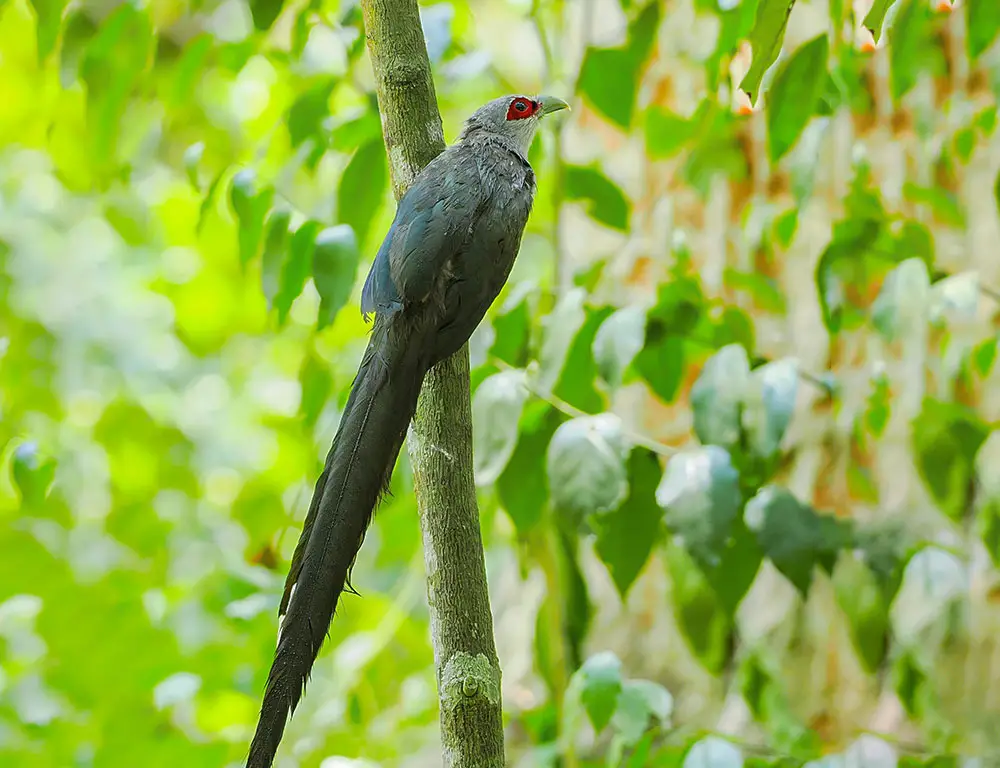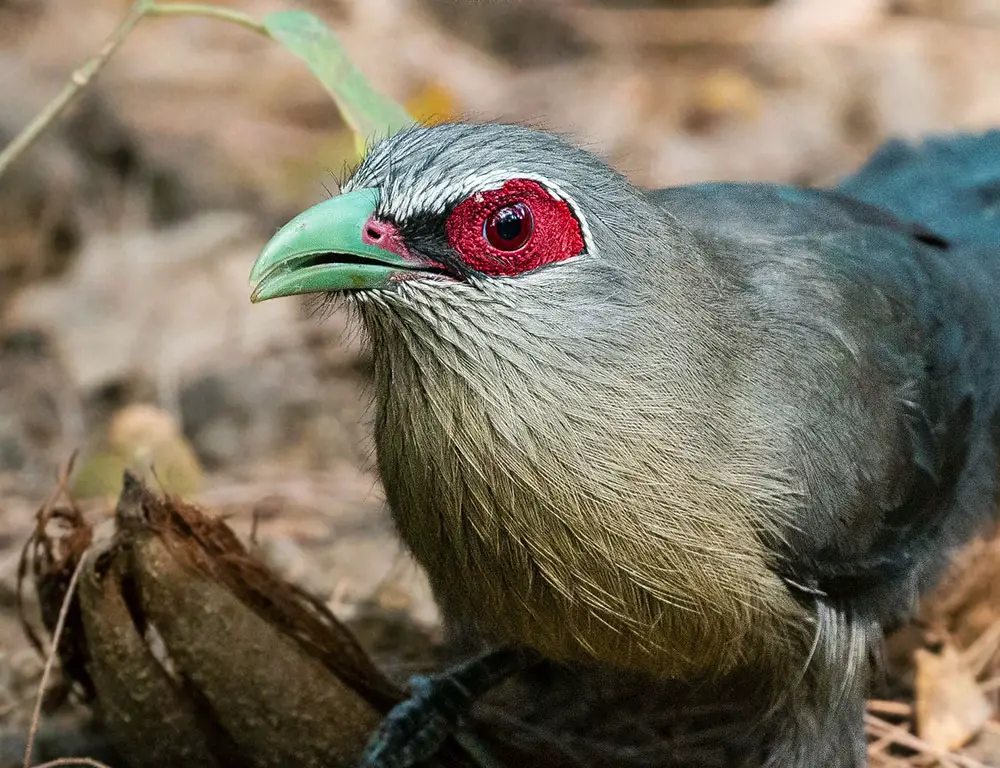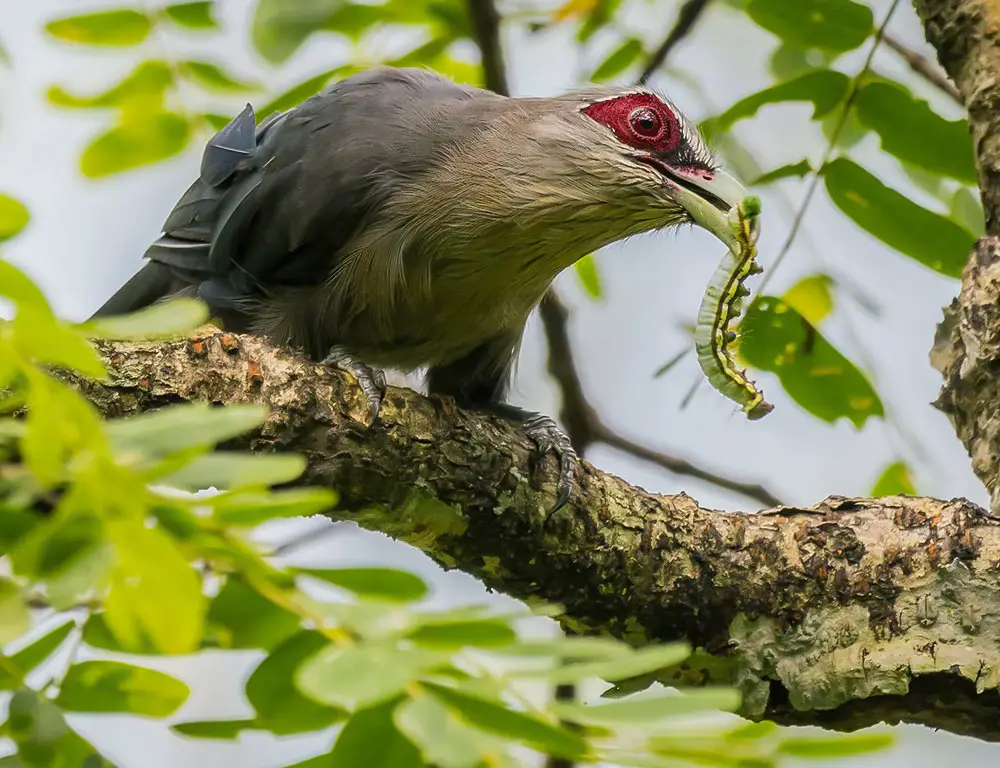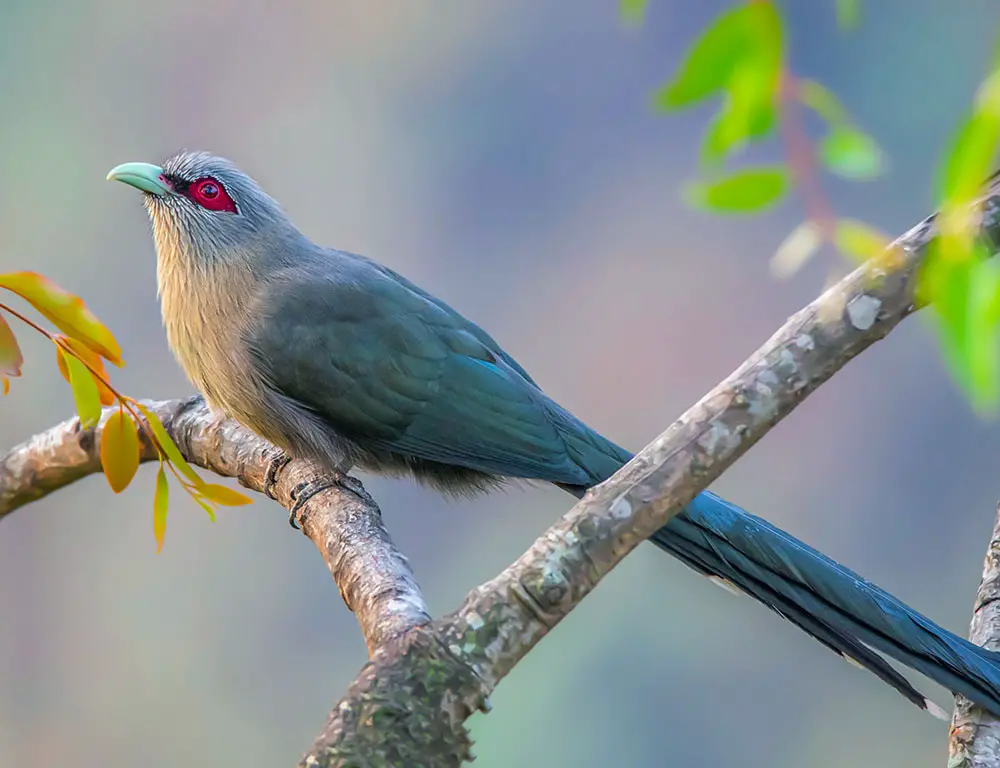Nestled within the verdant landscapes of Southeast Asia, the Green-Billed Malkoha emerges as a beacon of fascination for bird enthusiasts and nature lovers alike.
With its glorious green bill and intricate, elongated tail, this enigmatic species exudes an aura of mystique and allure.
Despite its striking appearance, the Green-Billed Malkoha remains elusive, weaving seamlessly into the dense foliage of forests, plantations, and gardens where it thrives.
What distinguishes this avian marvel is its peculiar call, a melodic yet unexpected sound echoing through its lush habitat.
However, the mystery surrounding the Green-Billed Malkoha persists, as its secretive nature has limited extensive research efforts.
Each revelation about this captivating bird adds another layer to unraveling the complexities of its existence, enticing us to delve deeper into its stunning world.

Physical Characteristics of Green-Billed Malkoha
The Green-Billed Malkoha’s physical characteristics make it a remarkable bird, distinct from many others in its habitat.
Here’s a detailed look at its vital physical features:
Size and Shape
The Green-Billed Malkoha is a medium-sized bird, measuring approximately 50–60 centimeters (19.7–23.6 inches) in length, including its tail. It has a relatively large body with a long tail, often extending beyond its body length.
Weight
The weight of the Green-Billed Malkoha typically ranges between 100 and 128 grams (approximately 3.5 to 4.5 ounces). This weight range applies to adult birds of this species.
Plumage
The plumage of the Green-Billed Malkoha is predominantly dark greenish-gray, providing excellent camouflage in its forest habitat. The body feathers exhibit a glossy sheen, adding to its visual appeal.
The wings are typically a darker shade of green, while the tail feathers are black with white tips, creating a striking contrast.
Head and Bill
The head of the Green-Billed Malkoha features a distinctive red patch around the eyes, contrasting with the surrounding dark plumage. As the name suggests, its bill is bright green and slightly curved, providing a sharp tool for capturing prey.
Eyes

The eyes of the Green-Billed Malkoha are a deep red color, further enhancing its striking appearance. They stand out prominently against the bird’s dark plumage, adding to its captivating gaze.
Tail
One of the most notable features of the Green-Billed Malkoha is its long tail, which is often longer than its body. The tail feathers are black with white tips, arranged in a pattern that adds to the bird’s elegance in flight.
Wings
The wings of the Green-Billed Malkoha are relatively short and rounded, suited for maneuvering through dense vegetation in its forest habitat. They display a subtle green coloration that blends seamlessly with the surrounding foliage.
Habitat and Distribution of Green-Billed Malkoha
The habitat and distribution of the Green-Billed Malkoha are closely tied to the lush and diverse landscapes of Southeast Asia.
Here’s a detailed overview of its habitat preferences and geographical distribution:
Habitat
The Green-Billed Malkoha is typically found in dense forests, thickets, and wooded areas with abundant vegetation. It thrives in tropical and subtropical environments characterized by various tree species, providing ample cover and nesting sites.
Riparian habitats, such as areas along rivers or streams, are also favored by these birds due to the dense foliage and availability of water.
Distribution
The Green-Billed Malkoha is native to various countries in Southeast Asia, including:
- Thailand: It is found in different regions of Thailand, including both lowland and upland forests.
- Malaysia: Prevalent in Peninsular Malaysia, particularly in forested areas and plantations.
- Cambodia and Laos: Present in forested regions and riparian habitats across these countries.
- Other Southeast Asian Countries: Additionally, Green-Billed Malkohas have been recorded in different regions, including Indonesia, Myanmar, Vietnam, and the Philippines, where suitable habitats exist.
Their distribution within these countries can vary depending on habitat availability, elevation, and local environmental conditions.
Behavior and Diet of Green-Billed Malkoha

The behavior and diet of the Green-Billed Malkoha offer fascinating insights into its ecological role and survival strategies. Here’s a detailed look at these aspects:
Behavior
The behavior of the Green-Billed Malkoha offers fascinating insights into its ecology and interactions within its environment. Here are some key aspects of its behavior:
Breeding
Green-Billed Malkohas are known for their monogamous breeding behavior, typically forming long-term pair bonds.
Both male and female birds participate in nest-building, which involves constructing nests from twigs and leaves high up in trees or shrubs to protect their offspring from ground predators.
They often lay two to three eggs per clutch, with the incubation period lasting around 15 days.
Parental Care
After hatching, both parents feed and care for their chicks until they are ready to fend for themselves.
This cooperative parenting behavior ensures the survival of the offspring and highlights the importance of teamwork in raising young Malkohas.
Foraging
Green-Billed Malkohas are primarily insectivorous, feeding on various insects and small reptiles found in their forest habitats. They are skilled hunters, using their long tails for balance as they hop along branches in search of prey.
Additionally, they have been observed consuming fruits, mainly berries, adding variety to their diet.
Solitary Nature
While they may form pairs during the breeding season, Green-Billed Malkohas are generally solitary birds, preferring to forage alone or in small family groups. Their secretive behavior and camouflage help them avoid detection by potential predators.
Diet
The diet of the Green-Billed Malkoha primarily consists of insects, although it also includes a variety of other prey items. Here’s an overview of its diet:
Insects
Insects form a significant portion of the Green-Billed Malkoha’s diet, with caterpillars being a favorite snack. They are adept at foraging among leaves and bark, using their sharp bills to extract prey hidden within foliage.
Small Reptiles
Alongside insects, small reptiles like lizards may also be part of the Malkoha’s diet. Their agile hunting skills enable them to efficiently capture and consume these prey items.
Fruits
While insects and reptiles constitute the primary food sources, Green-Billed Malkohas also supplement their diet with fruits, especially during seasons when insects may be less abundant.
They show a degree of dietary flexibility, adapting to changing food availability in their environment.
Drinking Behavior
Green-Billed Malkohas have a unique drinking behavior where they fully immerse their bills into water sources such as puddles or tree cavities filled with rainwater before drinking.
This behavior sets them apart from other bird species and reflects their adaptation to their forest habitat.
Conservation Status of Green-Billed Malkoha

The Green-Billed Malkoha, although not currently classified as endangered or threatened, faces significant conservation challenges primarily due to habitat loss and degradation.
Here’s a closer look at its conservation status:
Habitat Loss
Rapid urbanization, agricultural expansion, and deforestation are shrinking the natural habitats of the Green-Billed Malkoha across Southeast Asia. Destruction of forests directly impacts their nesting and feeding grounds, leading to population declines and fragmentation.
Population Decline
The estimated population of Green-Billed Malkohas has shown a steady decline over the past two decades, as indicated by the numbers provided:
| Year | Estimated Population |
|---|---|
| 2000 | 500,000 – 1 million |
| 2010 | 400,000 – 800,000 |
| 2020 | Less than 500,000 |
This decline underscores the urgency of conservation efforts to prevent further population loss and ensure the species’ long-term survival.
Conservation Measures
While the Green-Billed Malkoha is not currently listed as endangered by significant conservation organizations such as the IUCN or BirdLife International, proactive measures are essential to mitigate future risks.
Conservation efforts should prioritize habitat protection, restoration, and sustainable land management practices to safeguard critical habitats for the species.
Public Awareness and Education
Increasing public awareness about conserving the Green-Billed Malkoha and its habitat is crucial. Education initiatives can help promote conservation-minded practices and encourage local communities to participate in conservation efforts.
Research and Monitoring
Continued research and monitoring are essential for understanding population trends, identifying critical threats, and informing conservation strategies.
Research on the ecology, behavior, and habitat requirements of the Green-Billed Malkoha can provide valuable insights for conservation planning and management.
FAQs
What is the scientific name of the Green-Billed Malkoha?
The scientific name of the Green-Billed Malkoha is Phaenicophaeus tristis.
How does the Green-Billed Malkoha reproduce?
Green-Billed Malkohas are monogamous and typically breed during specific seasons. Both male and female birds participate in nest-building, incubating eggs, and caring for the young.
What are the threats to the Green-Billed Malkoha’s population?
The Green-Billed Malkoha faces threats from habitat loss due to deforestation, urbanization, and agricultural expansion. Additionally, factors like climate change and pollution may also impact their habitat and food sources.
How can I identify a Green-Billed Malkoha in the wild?
Look for a medium-sized bird with predominantly dark greenish-gray plumage, a bright green bill, and a long, patterned tail with white-tipped feathers. Their distinct red eyes and melodious calls are also identifying features.
Are Green-Billed Malkohas considered endangered?
While not currently classified as endangered, the declining population trends and habitat loss highlight the need for conservation efforts to ensure the long-term survival of the Green-Billed Malkoha.
Conclusion
The Green-Billed Malkoha stands as a captivating emblem of nature’s intricate beauty. Its vibrant green bill, long, white-tipped tail, and striking blue-eye markings portray diversity within our ecosystems.
Delving into its behaviors reveals a creature both visually stunning and behaviorally unique, offering valuable insights into avian biodiversity. As we appreciate the Malkoha’s distinctiveness, we’re reminded of the vast complexity of life on Earth.
Our journey into understanding such remarkable species enriches our knowledge and broadens our perspective on the interconnectedness of all living things.
Let’s continue to explore and cherish nature’s wonders together, as countless mysteries are still waiting to be unveiled.